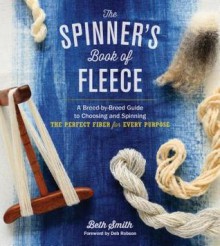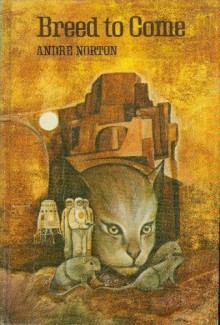

by Beth Smith
This is a very practical book about spinning which gives a little background, but focuses mostly on types of fleece and their respective purposes.
The author explains the value of raw fleece and the differences in different types such as longwools, downs and multicoated breeds. Relative strengths and advantages to different breeds are covered as well as the options to buy raw or processed wool, how to find sources, how to get consistent yarn and what wools take dye best.
There is a chapter on buying fleece dos and don'ts that contains a lot of valuable information. Cleaning, storing and tools are all discussed in detail and spinning basics are included for noobs like myself. The information about different fibers and how much to buy for specific projects was something I found very valuable. How to keep bugs out of your wool was also of great value.
There are chapters that go into detail about each type of wool, how to wash and comb it and just about anything you might want to know about how to prepare your wool for spinning.
This is the most thorough book about spinning and choosing/preparing yarn that I have come across. It finishes with a glossary of terms plus charts and resources that make the idea of taking up this craft feel much less daunting.

I discovered this book because one of the people I follow (Clara, I believe) has it shelved so I noticed it.
Stranger's book is about a change in British lie as the modern world encroaches on the rural areas. The focus is mainly on the Shire breeder Josh, but there is enough about other members of the village that Stranger paints a lovely picture. And modern life/city dwellers aren't painted with a board brush either, as showcased by the new school teacher.
It is a true read, not cute and fluffy animals, but unlike some books that are supposedly about animals and only use the death of the animal to install a lesson or make someone cry, Stranger's death can be bleak but they feel nature, so they hurt a bit less. It's like watching a BBC Earth show with less wild animals.
I will be reading more by this author.

Furtig is one of the People (cat people), a descendant of Gammage. Gammage was physically different - his fur was sparser and his fingers longer. He also believed that the tools and knowledge left behind by the Demons (human beings) could be useful. It was he who developed metal claws that allowed the People to more effectively hunt, as well as fight against the Barkers, Tuskers, and Rattons. When Furtig fails his Trial and chance to secure a mate, he opts to leave his tribe and go to Gammage, who is rumored to somehow still be alive and seeking to unite the People and even ally with the Barkers and Tuskers against a common enemy...the Demons. The Demons disappeared or died out long ago, after killing many of the People in their madness. Could they really be returning?
I first read this when I was in the 5th grade. We'd been given an assignment to read a certain number of science fiction books, and at the time I was firmly a fantasy reader and felt that science fiction was not for me. Then I discovered that Andre Norton had written science fiction starring cats, and I changed my mind.
I don't know that I can really call this a reread. I know I read it before, but I didn't feel one bit of recognition during this "reread," to the point that I might as well have been reading it for the first time.
Norton's style was a bit stiffer than I recalled, and I didn't really settle into the story until after Furtig met Foskatt and Gammage. I enjoyed Furtig's encounters with "Demon" technology - sometimes it was easy to figure out what sort of device he was using, and sometimes I couldn't be sure. Furtig's discovery that he had slight psychic powers was a bit much, but they thankfully weren't overused.
Norton's vision of humanity in this was...not exactly flattering. We basically screwed up multiple times, and then made things worse when we tried to fix our mistakes. The overall message: technology is nice and all, but go too far and you'll kill yourself. It struck me as being both simplistic and depressing,
especially considering how Norton hammered it home at the end.
The whole setup with the People, Barkers, Tuskers, and Rattons, made sapient by the mistakes that ultimately killed humanity, was interesting enough. And yeah, I can definitely understand why animal-loving 5th grade me latched onto this and Norton's other cat-focused books. However, in my reread one thing that really bothered me was how hard Norton leaned on rat stereotypes. The Barkers and Tuskers were allowed to be more complex - they could be reasoned with and potentially become allies to the People. The Rattons, on the other hand, were just plain evil, resorting to torture and horrible traps. It struck me as lazy, compared to the way the Barkers and Tuskers were depicted.
All in all, not a bad reread, but a bit more of a downer than I expected.
(Original review posted on A Library Girl's Familiar Diversions.)

Andre Norton just gave the psychic cat-man a light saber. Or maybe a Star Trek-style phaser, it's tough to tell from the description.
I'm enjoying this more, now that Norton's gotten most of the background info out of the way. The history of the cat (and other animal) people in this world reminds me of M.C.A. Hogarth's Pelted Universe (which I recommend) and the cat and dog people in Mary E. Lowd's Otters in Space (which I unfortunately don't recommend). I wouldn't be surprised to learn that both of them had read this book and were influenced by it.